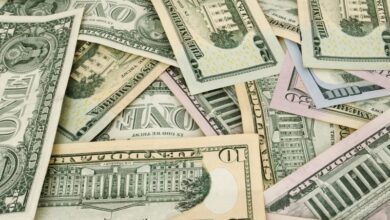Australian dollar dips below US64¢ as Federal Reserve chairman Jerome Powell flags interest rates to stay higher for longer

The Australian dollar fell as low as US63.88¢, its weakest since November 14, before bouncing back to trade at US64.14¢ as investors pushed out the likely timing of a US rate cut to November.

Traders had only just priced in a September rate move from the Fed on Tuesday (AEST) after US retail sales figures for March came in almost double what economists had forecasts, underscoring the resilience of the US consumer and a surprisingly robust economy.
Markets had been banking on the world’s most influential central bank kicking of a global rate cutting cycle mid-year, which had helped drive equity markets to record highs.
But Mr Powell’s comments compounded investor fears, with the market now expecting the Fed to lower borrowing costs by just 40 basis points this year. That compares with the six rate cuts totalling 150 basis points priced in by market at the start of the year.
Australian investors have also reduced the chance of an interest rate cut by the Reserve Bank in 2024, implying two-in-three probability of a move lower by December. Still, they remain fully priced for a cut by the RBA in February next year.
“[Powell] has acknowledged that inflation will take longer to come down, which means interest rates will have to stay higher for longer,” said National Australia Bank’s senior FX strategist, Rodrigo Catril.
“We’ve seen that in the move up in US bond yields, which has been very supportive of the dollar, and obviously is putting downward pressure on the Australian dollar.”
NAB has abandoned its end-of-year target for the Australian dollar to hit US70¢ after the robust retail figures.
Mr Catril also cited heightened geopolitical tensions, such as the US election in November, as another factor that could keep the Australian dollar under pressure in the near term. Even so, he expects the currency to hit US69¢ by the end of 2024.
“The market will be more comfortable with the idea that easing by the Fed should come later this year,” he said. “It’ll be an important component to the US dollar going down.”
Kris Bernie, from Kapstream Capital, said the Fed’s reassessment of inflation meant that the RBA would be more comfortable keeping rates on hold because there was now less risk of a significant appreciation in the Australian dollar from the Fed easing earlier.
The local dollar has shed nearly 6 per cent this year because US interest rates are more attractive to bond investors than their Australian counterparts.
“Markets have gone from pricing way too much Fed easing to something closer to fairly priced,” Mr Bernie said.
Emerging market currencies were also hit overnight by the Fed’s more hawkish comments, with the Brazilian real and Mexican peso among the biggest decliners amid a resurgent greenback.
One outlier in the developed markets was the Kiwi dollar, after local data showed New Zealand’s inflation slowed to the weakest in almost three years on an annual basis to 4 per cent from 4.7 per cent. That helped lift the Kiwi dollar to trade about US59¢.





